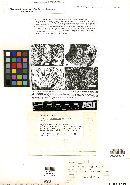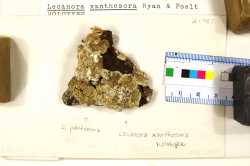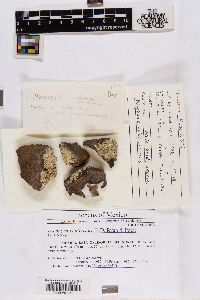
Consortium of Lichen Herbaria
- building a Global Consortium of Bryophytes and Lichens as keystones of cryptobiotic communities -
- Home
- Search
- Images
- Species Checklists
- US States: O-Z >
- US National Parks
- Central America
- South America
- US National Parks
- Southern Subpolar Region
|
|
|
|
Family: Lecanoraceae
|
Nash, T.H., Ryan, B.D., Gries, C., Bungartz, F., (eds.) 2004. Lichen Flora of the Greater Sonoran Desert Region. Vol 2. Thallus: crustose to +placodioid, usually forming distinct rosettes 2-4 cm in diam., 0.5-1 mm thick, tightly adnate, rimose-areolate to areolate-verrucose; prothallus: absent or indistinct areoles: flat to slightly convex, sometimes sinuous, usually not distinctly swollen or foveolate, 0.5-1 mm in diam. lobes: usually distinctly radiating, contiguous, sometimes distinct to center of thallus, usually relatively narrow and linear, 1.5-2(-10) mm long, 0.5-1 mm wide, flat to slightly convex; tips: often finely crenate or incised, not strongly broadened upper surface: when fresh mostly grayish yellow to almost light yellowish brown (the outer 0.5-1 mm of lobe tips often much paler, pale yellow to white or slightly green; in herbarium usually grayish yellow to moderate yellow), often covered with pale yellow powdery material and with minute (c. 0.1 mm in diam.), easily abraded pustules, sorediate soredia: often present on thallus center but sometimes poorly developed, often in round to irregular, flat-topped areas (1-3 mm diam.) which are erumpent to slightly raised, mostly pale greenish yellow to pale yellowish green or yellowish white, sometimes with a bluish tint, granules somewhat distinct but soft and eroding anatomy: mostly similar to that of L. pachysoma upper cortex: often poorly developed or eroded, uneven above, 15-25(-35) µm thick, the hyphae weakly conglutinated medulla: solid, appearing cottony, not chalky; algal layer: very irregular, interrupted and diffuse, c. 40 µm thick, with glomerules partly extending into medulla lower cortex: absent Apothecia: absent to occasionally rather abundant, mostly poorly developed and only partly opened, soon constricted sessile, borne submarginally one to several per areole in thallus center, 1.5-3 mm in diam. disc: concave to plane margin: strongly raised and inflexed when young, becoming +even with disc, 0.3-0.6 mm wide, entire to lobed and crenate, smooth to radiately cracked and wrinkled, often abraded and more white than thallus, without a parathecial ring amphithecium: present, with algae filling most of amphithecium and extending as a layer (c. 50 µm thick) below the hypothecium, medulla filled with xanthone granules (soluble in K)and zeorin crystals (c. 30 µm long, 1-3 µm wide), corticate; cortex: similar to that of the thallus parathecium: pale yellowish brown, composed of dense, conglutinated hyphae very narrowly parallel hyphae, sometimes with small yellowish oil droplets epihymenium: with c.10 µm thick superficial layer of coarse, greenish gray to yellowish brown, refractive granules (partly soluble in K), partly penetrating deeper into hymenium hymenium: hyaline, often immature, becoming 35-80 µm tall; paraphyses: coherent; tips: little thickened 1.5-2.5 µm; subhymenium: pale yellowish brown, c. 30 µm thick, often with oil droplets; hypothecium: mostly with periclinally to randomly oriented hyphae ascospores: hyaline, simple, narrowly ellipsoid, when mature (6-)8-12(-14) x 3-4(-5) µm Pycnidia: rare, inconspicuous; conidiophores: type III of Vobis (1980) conidia: filiform, 12-15(-17) µm long Spot tests: cortex: K+ yellow, C+ orange, KC+ yellow-orange, P+ yellow; medulla K+ yellow, C+ orange, KC+ orange-red; discs C+ and KC+ orange-red Secondary metabolites: thiophanic acid major, arthothelin and isoarthothelin in trace amounts or absent; UV+ white unknowns LPN-1 and 2 absent; UV+ blue unknown LPC-1 present; several other unknowns (different from those in L. pachysoma) present in minor or trace amounts. Substrate and ecology: on various volcanic and metamorphic rocks, often on tops of exposed boulders and outcrops World and Sonoran distribution: Baja California, Sinaloa and southern California, at 7-90 m, very abundant in some areas. Notes: Lecanora xanthosora differs from L. pachysoma (as well as from L. pinguis, found just north of our region), by the frequently abundant soredia-like granules, thinner, more gray to brown tinged thallus (often much paler at the margin) with narrower lobes, smaller central areoles, and more uneven and often abraded cortex. Lecanora pachysoma can usually be distinguished from L. xanthosora (as well as from L. pinguis) by the rather deep greenish yellow thallus color (when fresh) and by the more discrete, central areoles, which frequently are sinuous, swollen and foveolate. |
Powered by Symbiota


















